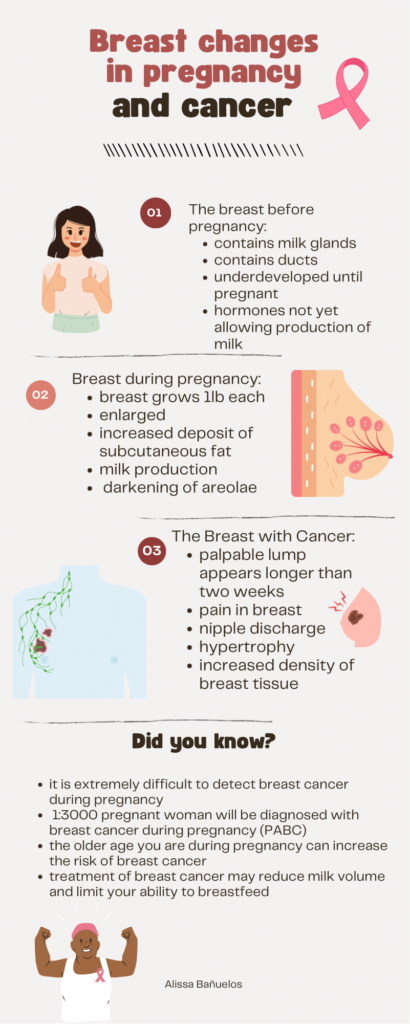Before pregnancy, a female’s breasts contain milk glands and ducts, however they are underdeveloped. The breast’s mammary gland structure is typically rudimentary during this stage as well, but all this changes when a person goes through pregnancy. During pregnancy, the body goes through many changes, many of which are in the breasts which are caused by the hormones estrogen, progesterone, and prolactin. Some of these changes include enlargement of the breasts, increased deposit of subcutaneous fat in the breast, milk production, darkening of areolae, and more. Typically, the breasts will grow about one pound each, and will eventually start to produce milk. With this, comes the possibility of problems that females might go through like painful enlargement of the breasts, cracked nipples, mastitis, plugged ducts, thrush, and even breast cancer.
Breast cancer is the most common cancer to occur during pregnancy and is known as pregnancy associated breast cancer (PABC) (Levey & Krishna, 2022). Due to the physiological changes a female’s body goes through during pregnancy, it is difficult to detect breast cancer. The articles by Levey and Krishna (2022) and Boere et al. (2022) both explain that breast cancer symptoms include engorgement, nipple discharge, hypertrophy, and increased density of the breast tissue, all of which are not uncommon symptoms to have during pregnancy. Keyser et al. (2012) goes on to say that because breast cancer is difficult to detect in pregnancy, most cases tend to be more advanced with larger tumors. If a palpable mass is detected in the breast or around axillary area, and stays longer than two weeks, it needs to be evaluated. This can be done by ultrasound and then by mammography if there is any suspicion that the mass could be malignant (Levey & Krishna, 2022). Once breast cancer is detected, all options and forms of treatment should be carefully considered.
Some forms of treating breast cancer are through surgery, radiotherapy, or chemotherapy. Each of these options should be taken into consideration on how it will affect the mother and the fetus. It is important to note that termination of the pregnancy will not change or affect the outcome of the prognosis (Keyser et al., 2012). If the patient decides to have the surgery at any point throughout the pregnancy, it is possible without harming the fetus. Radiotherapy, however, should only be done in the first and second trimester. If the female decides chemotherapy is a more appropriate course of treatment, it is possible only after the twelve-week mark of gestational age of the fetus (Boere et al., 2022). Treatment of the cancer may cause some complications with milk production in the future. According to Keyser et al. (2012), after being treated for breast cancer, there may be a reduced milk volume and scar tissue which could affect the ability to breastfeed.
Overall, the effects that pregnancy has on the breast are great, and tumors caused by breast cancer make it even more complicated. Pregnancy-associated breast cancer affects the female and fetus in more ways than just one, and it’s important to decide what is best for the family and patient to achieve the outcome they want.
REFERENCES
Levey, N. & Krishna, I. (2022). In Pregnancy: Caring for the Very Young Breast Cancer Patient from Diagnosis Through Survivorship. Obstetrics and Gynecology Clinics of North America, 49(1), 181-193.
Boere, I., Lok, C., Poortmans, P., Koppert, L., Painter, P., heuvel-Eibrink, M., Amant, F. (2022). Breast Cancer During Pregnancy: Epidemiology, Phenotypes, Presentation During Pregnancy, and Therapeutic Modalities. Best Practice & Research Clinical Obstetrics & Gynaecology, 82, 46-59.
Keyser, E., Staat, M., Fausett, M., Shields, A. (2012). Pregnancy-Associated Breast Cancer. Obstetrics & Gynecology, 5(2), 94-99.


The objective covered is “explain how the breasts change during pregnancy”
Alissa’s STEAM project goes over what breast cancer is and how it can be affected during pregnancy. Her compelling artwork displays breast changes before and during pregnancy as well as breast with cancer. What I found intriguing was how hard breast cancer can be detected during pregnancy and how it increases the chances of getting breast cancer the older you are. The breast before pregnancy is underdeveloped before pregnancy, they contain ducts and milk glands. During pregnancy, physical changes occur such as being enlarged, darkening or areolae, and growing about a pound each. Due to pregnancy hormones, breasts will feel tender and fuller. Breast cancer symptoms are hypertrophy, engorgement, nipple discharge, and increased density of the breast tissue. Other Physical signs of breast cancer may be a palpable lump that is there longer than two weeks, and pain in breast. Treatments of breast cancer may include; surgery, chemotherapy, hormonal therapy, and radiation therapy. During the surgery, the doctor will cut out the cancer tissue. Chemotherapy uses unique medicine to kill or shrink the cancer cells. Hormonal therapy blocks cancer cells from getting the hormones they need to grow. Radiation therapy uses high energy rays to get rid of cancer cells. These options will need to be taken into consideration and even with terminating the pregnancy this will not change the prognosis. Surgery may not affect the fetus; however, radiotherapy should only be done during the 1st and 2nd trimester. Any treatment for cancer may cause complications with milk production. 1:3000 pregnant women will be diagnosed with breast cancer during pregnancy.
Great work Alissa!